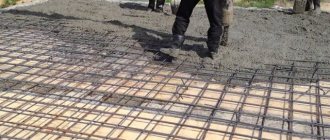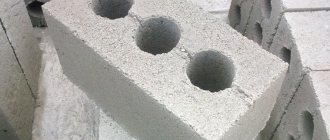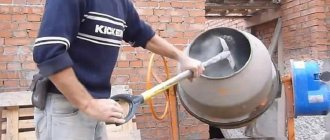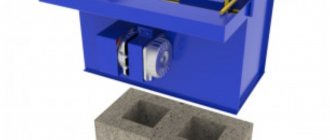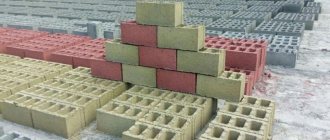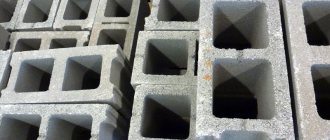Cinder block as a building material
Cinder block is a building material that contains slag, concrete mixture, cement, and other additives. The material is shaped like brick. Even inexperienced builders can make cinder blocks on their own.
If the volumes of cinder blocks produced are large, it is recommended to make a special machine, which is placed directly at the construction site. If you follow the steps for preparing the building material, and also strictly follow the recipe, you get a high-quality cinder block.
What you need to consider when organizing a business for the production of aerated concrete blocks
The production of material with low cost and high demand makes this type of business very attractive. But in order to get maximum profit, you should take into account some nuances. First of all, the seasonality of demand should be taken into account, therefore, in order for the first year of operation not to be unprofitable, production should be launched a month or two before the start of the construction season , having accumulated a certain stock of products in warehouses. It should also be taken into account that the main category of clients are private developers, so it is necessary to constantly work to increase sales by attracting the maximum number of new clients.
When choosing a premises for rent, you should be guided by several points: its area must be sufficient to accommodate a production line , a warehouse for raw materials and a warehouse for finished products. In addition, it must be possible for vehicles to enter. The room must be sufficiently dry and warm , in addition, water supply and a three-phase electrical network with a voltage of 360V must be supplied.
Scope of application
Cinder block is not intended for the construction of buildings higher than one floor. This material is used for the following types of buildings:
- garages;
- one-story residential buildings;
- sheds for keeping livestock;
- temporary buildings;
- country houses;
- workshops.
When building higher residential premises, for example, frame houses, this material is used as insulation.
It is not recommended to build multi-story buildings from cinder blocks due to the low load-bearing capacity of the material.
Buildings built from this material have advantages and disadvantages. Benefits include:
- low probability of fires;
- strength;
- efficiency;
- resistance to temperature changes;
- high speed and ease of construction;
- long service life;
- high rates of sound insulation;
- resistance to biological destruction.
Along with its advantages, the building material has a number of disadvantages. These include:
- toxicity;
- hygroscopicity, that is, high ability to absorb moisture;
- low thermal insulation, which is why buildings need additional insulation;
- difficulties when laying pipes in a cinder block building;
- problems when pulling cables in a building;
- unaesthetic appearance.
The characteristics listed above force builders to use more expensive building materials to insulate the building, insulate the walls from moisture and finish the walls on the outside.
The basis of the building material, slag, sometimes contains acids and sulfur, which are unfavorable to human health, so it is recommended to weather this material in the open air for a year.
Which one is better to choose?
Choosing the wrong foundation can affect the longevity of your garage
The biggest problem in private construction, which is carried out on its own, is the correct choice of foundation. Its quality determines how long a garage or house will last without requiring major repairs.
Often, decision-making is complicated by the fact that for the same situation you can get conflicting advice from both professionals and private individuals with experience in independent construction. The correct decision in this case would be to rely on the norms and rules for the construction of buildings recorded in official documentation.
Selection of foundation depending on ground water level and TPG
An important criterion for choosing the type of foundation is the depth of groundwater. This indicator directly affects the degree of heaving (mobility) of the soil. It is expressed in soil displacement in the off-season, which is characterized by alternating periods of freezing and thawing.
The groundwater level indicator is closely related to such a criterion for choosing the type of foundation as TPG (soil freezing point). In combination with the groundwater level, they determine how mobile the soil is at the construction site. Having decided to build a garage from cinder blocks, first of all they find out the UGV and TPG.
Next, they focus on SNiP 2.02.01-83 “Foundations of buildings and structures.” Study table No. 2 and make sure that the depth of the foundation does not depend on the depth of soil freezing if the groundwater level is 2 m below it (TPG). This is true for the following types of soil:
- rocky;
- coarse-clastic;
- sandy loam;
- loams;
- clayey;
- silty-clayey.
In most cases, the situation at the construction site is such that the groundwater level is located below the TPG by more than 2 m. Consequently, the developer has a wide choice: any of the foundations listed above will be suitable for a garage made of cinder blocks. Its type is determined based on your financial capabilities and availability of materials.
Specifications
There are a number of technical characteristics of cinder blocks, depending on which they are divided into types. The building material is suitable for certain jobs, depending on its technical qualities.
Types of building material
There are several types of building material, depending on which it is used for certain purposes. Building materials are distinguished according to two parameters:
- degree of emptiness;
- thickness.
The table shows the types of cinder blocks according to the degree of voidness, their properties and recommended areas of application are given.
| Type of cinder block | properties | application area |
| full-bodied |
|
|
| hollow (degree of hollowness – 40%) |
|
|
| hollow (degree of hollowness – 25 – 40%) |
|
|
Depending on the standard dimensions, cinder blocks are divided into:
- wall (dimensions - 390 x 190 x 188 mm);
- partition (dimensions - 390 x 90 x 188 mm).
When asked whether it is necessary to adhere to standard sizes when producing materials independently, recommendations are given to maintain stable dimensions, that is, to produce cinder blocks of the same size.
Strength grades of cinder blocks
The strength of a building material is determined by coefficients from 10 to 125. The degree of strength is directly proportional to the increase in the coefficient - the higher the coefficient, the higher the degree of density and strength of the material.
The lowest density of cinder block is 750 kg/m3. The highest figure is 1450 kg/m3.
When constructing buildings that require communications, it is not recommended to use the strongest cinder block, since it cannot be cut or turned.
General requirements when performing work
You can make good blocks in the garage - the main thing is to know the technology and stick to the recipe. So, a standard cinder block is 39x19x188 mm, with small three holes
And to make it high quality and durable, it is important that:
- The sand was coarse;
- Slag – blast furnace;
- Cement – high quality, not less than M400;
- Equipment – with vibrocompression.
The slag itself is obtained by processing coal, and, in fact, it is an ideal filler for blocks. However, recently, thanks to the active conduction of gas, much less slag and ash from coal has begun to be produced. Therefore, slag is increasingly being replaced with zito concrete, which, unfortunately, is much more expensive.
One of the most important requirements for the quality of cinder blocks is their geometry. After all, the larger the unevenness and flaws in the blocks, the more money you will have to spend on the construction of walls
And in order for the cinder block to turn out perfectly smooth, it is important that the vibroform itself is always filled to the brim - otherwise the blocks will turn out crooked. And not just to the brim - but with a slide, because the vibration will then slightly shake the concrete
The whole process looks like this: the vibrating mold is turned on once, after 5-15 seconds it turns off, and the level of the solution in the mold is assessed - if it is below the edges of the mold, you need to put a clamp on, turn on the vibration again - and when it hits the limiter, turn it off. This must be done at the same time: turn on the vibrator and pull out the shape.
Composition of the mixture for the manufacture of building material
The basis of the composition for making cinder blocks is slag. It is a metallurgical waste product formed after the separation of metal components from ore. It is divided into two types:
- granulated;
- non-granular.
The first type is included in the composition of concrete for cinder blocks. It is called granulated slag. The second type of material is used for other purposes - the production of paving slabs and road surfaces.
Depending on the type of production, the following subtypes of slag are distinguished:
- waste generated by coal combustion;
- ferrous metallurgy waste;
- non-ferrous metallurgy waste.
When making cinder blocks with your own hands, it is not recommended to introduce waste from fuel combustion into concrete compositions, as they are toxic.
To save money, it is recommended to buy granulated slag obtained from ferrous metallurgy production processes, since non-ferrous metallurgy waste is more expensive.
Materials for making cinder blocks
There is a standard recipe for concrete for cinder blocks, which varies depending on the scope and purpose of use. The classic recipe includes the following components:
- slag;
- sand;
- gravel;
- cement;
- water;
- plasticizer
The table shows the recommended characteristics and ratio of materials used in the manufacture of cinder blocks.
| material | characteristics | ratio (in parts) |
| slag | · large; · granular; · sifted | 7 |
| sand | · large; · river | 2 |
| gravel/crushed stone | fraction – from 5 to 15 mm | 2 |
| cement | M 400 – M 500 | 1,5 |
| water | 1,5 – 2,5 | |
| plasticizer for concrete | if not available, replace with PVA glue, plaster | according to the manufacturer's recommendation |
The amount of water depends on the method of production of the building material. When using the method without pressing, when the mixture is placed in a mold, up to 3 parts of water are required.
To improve the quality of the solution, a plasticizer is added to it. Due to this, the blocks do not crack during drying.
To produce colored blocks, crushed brick chips and colored chalk are added to the composition.
When making cinder blocks, it is recommended to calculate the cement consumption in advance. The higher its quality, the lower its consumption. M 500 cement is consumed 10–15% less than M 400 cement. The use of low quality cement is not recommended, because the resulting cinder blocks will be brittle.
To check the thickness of the solution, a small amount is sharply thrown onto the ground. The optimal solution in terms of density crumbles, and when pressed in a fist, it gathers into one mass.
What are cinder blocks made of?
If we are talking about the composition from which blocks are made, then the first thing that comes to mind is, naturally, a typical filler for building blocks.
In 99% of cases, timber is used; being the cheapest (or rather free) of materials, it has always attracted attention. Crushed bricks, wood sawdust, which is indispensable in insulation, and metallurgical industry waste remaining after burning coal are often used as fillers.
But the highest quality material is considered to be one made from expanded clay, according to the proportion of the solution for This is a filler that occupies more than 50% of the volume of the cinder block, the rest is distributed between additional substances:
- sand;
- cements;
- water;
- other components.
It also happens that the material needs to be given additional strength. Then a plasticizer is added to the cinder block solution as a binder, which gives the material stability.
Important! When planning to make cinder blocks at home, please note that the plasticizer for cinder blocks is different from others, for example, those that are added to, etc.
Tools and equipment for the production of cinder blocks
The tools and equipment used for the production of building materials depend on the chosen production method. Cinder blocks are made in two ways:
- manually, using a form;
- on the machine.
They make the machine and the mold themselves. This requires a certain set of materials and tools.
The table presents the necessary materials and tools for the production of a mold and a machine for cinder blocks, and the stages of work are given.
| device | materials/tools | manufacturing stages |
| form |
|
|
| machine |
|
|
If a few blocks are required, for example, for the construction of interior walls in a room, they are made by hand. If a large amount of building materials is needed, for example, to build a barn or house, a machine is used.
Step-by-step instructions for laying cinder blocks with your own hands
Before starting work, the type of masonry is determined. It depends on the future structure. The thicker the wall, the warmer the building will be.
There are 4 types of installation:
- in two elements
- at one and a half
- into one
- half.
Builders call the latter method the spoon method. It is good for outbuildings, sheds, partitions, etc. Half blocks are chosen for it. For residential buildings, masonry of two or one and a half stones is used.
The masonry mortar is diluted from a ready-made mixture purchased in the store. You can cook it yourself. The basis of the composition is a mixture of three parts sand and one part cement. It is diluted with water to a viscous paste. It is advisable to add a plasticizer, which will reduce porosity, increase frost resistance and density of the solution.
It is better to buy a plasticizer. Cheap shampoo, which some professionals use for this purpose, may not give the desired effect. Mixing is best done in a concrete mixer. Manually it will not be possible to achieve the required homogeneity, which will significantly reduce the quality of the solution. In addition, you will need a lot of it. Manual kneading will increase the labor intensity of the work.
A few words about the foundation on which the blocks are planned to be laid. Its width should be equal to the width of the part. It is acceptable for it to exceed it a little.
Depositphotos
The top of the base is free of dents and bulges. If they exist, even if they are not large, they need to be leveled and sealed. Waterproofing is required. It is carried out in any suitable way.
Preparatory work
Laying cinder blocks with your own hands is similar to laying bricks
Particular attention is paid to laying out the first row. How correctly this is done determines the durability of the building and the evenness of its walls.
Therefore, they start with markings, which are carried out along the base. One block is laid at each corner of the foundation.
This must be done so that a regular quadrilateral emerges. After checking the row planes on which the marks are applied, they are securely fixed. This is a guideline for even laying. You need to stretch cords between the rows; they will be used to control the height of the elements. The cord is pulled very tightly, without sagging.
First row
Begin by preparing the solution. The batch is calculated so that it can be consumed in an hour, a maximum of one and a half. On average, a bucket of composition is required to lay four elements. This is what you should focus on. Sand and cement are poured into the concrete mixer, and the equipment is started. Water is poured in small portions until the solution reaches the desired consistency. At the end a plasticizer is added.
Step-by-step instructions for installing the first row:
- We collect the solution, apply it to the foundation, and distribute it evenly over the base. Important point: according to the instructions, the seam thickness is 10-15 mm. We take this into account when applying the mixture.
- We take the cinder block by the middle and bring it to the place of work. We unfold it in the desired direction and place it on the foundation.
- Determine the installation height of the part. If the upper edge protrudes above the stretched cord, take a mallet and, tapping it lightly, lower the element to the desired height.
- The weight of the stone will force some of the adhesive out of the seam. Carefully remove it and put it away.
- Similarly we place the second, then the third part.
Depositphotos
We take a level and a plumb line, check the horizontal and vertical of the wall being built. If there are errors, we remove them immediately. We bring the row to the end. Don’t forget to periodically check the location of the blocks.
Second and subsequent rows
You need to start laying the second, as well as all subsequent even rows, from half of the part. This ensures the necessary shift. You will have to cut the element yourself. This can be done with a hacksaw or a hand-held circular saw. Otherwise, the installation technology does not change. First, the cord is pulled at the desired height, then, guided by it, stones are placed. After laying two or three elements, control of the planes is required.
Reinforcement is used to reduce loads, strengthen the wall and prevent the occurrence of cracks. It is required in the first row, as well as in every fourth. For this, steel rods, a metal mesh with 5x5 cm cells, or a reinforcement frame made of galvanized steel are used. Additional reinforcement is required for all openings for doors and windows. Working at height with heavy parts is quite difficult. Before you start laying them, you need to take care of convenience and safety. The simplest solutions in the form of a stepladder or ladder are absolutely not suitable. They are too unstable and unsafe to work on.
Depositphotos
If possible, it is good to use a platform whose height can be adjusted. Scaffolding is also convenient, where everything you need can easily fit.
Reviews
Sergey Novoostrov, Lipetsk After graduating from university, my father expected me to become his assistant in business, but I had other plans - I wanted independence and dreamed of having my own business. Although not immediately, my father supported me and even helped me with the initial capital. I decided to start producing aerated concrete blocks, and I immediately had my first regular customer - my father’s construction company, which was engaged in the construction of country houses and cottages. Having a constant sales market and constantly expanding it, I managed to recoup the costs in one construction season. And next year I’m thinking about installing another line, also with a capacity of 60 cubic meters per day, since at first I didn’t even expect such a great demand for this material with amazing characteristics.
Vitaly Elizarov, Kolomna I have a small construction company, we are engaged in the construction of country cottages and dachas. Many customers prefer to build their houses from aerated concrete, so I decided that it would be rational to have a small factory for this. I purchased a 15 cube line and have been producing blocks since the end of February and all of March. Thus, by the beginning of the season, I am ready to provide these materials to all my clients for whom I will build houses this year. Everyone is happy: the client receives high-quality material at a slightly lower price than the market price, and I have the opportunity to earn additional income to develop my business.
Igor Okhotnikov, Tula Over ten years, my business, which began with a small mobile plant for the production of aerated concrete, standing in my yard at home, has turned into a large plant with the production of more than 1000 cubic meters of aerated concrete per day. This is a very profitable and profitable business, but it is necessary to constantly increase and expand your client base. You should work especially closely with construction organizations, offer them attractive options for purchasing goods, provide discounts - in the end, everyone will benefit.
How to find out how many bricks are in 1 m3 of masonry: calculation methods for different types of bricks. Reviews of the new building material Lego brick can be read in this article.
Beautiful home design in the photo: Bavarian brickwork.




